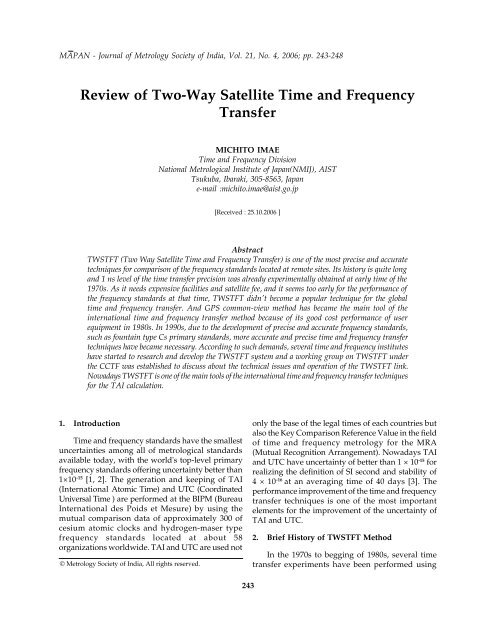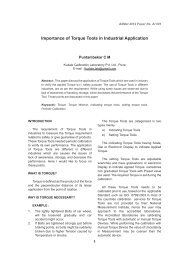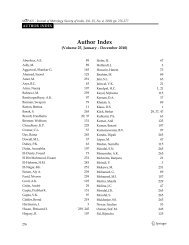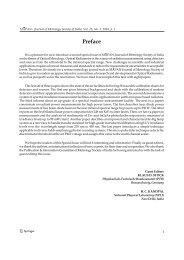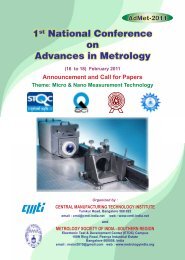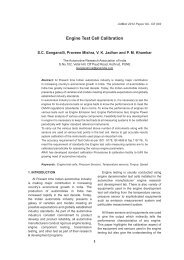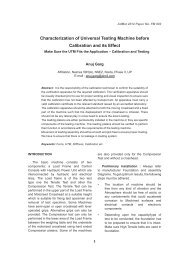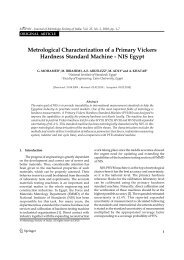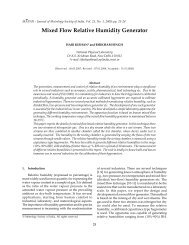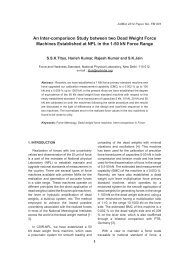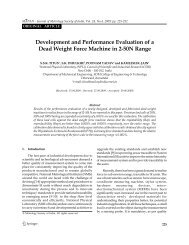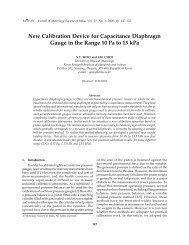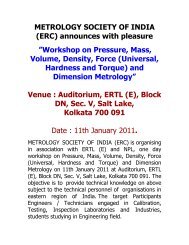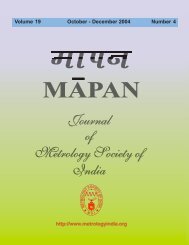Review of Two-Way Satellite Time and Frequency Transfer
Review of Two-Way Satellite Time and Frequency Transfer
Review of Two-Way Satellite Time and Frequency Transfer
Create successful ePaper yourself
Turn your PDF publications into a flip-book with our unique Google optimized e-Paper software.
MAPAN - Journal <strong>of</strong> Metrology <strong>Review</strong> <strong>of</strong> Society <strong>Two</strong>-<strong>Way</strong> <strong>of</strong> India, <strong>Satellite</strong> Vol. 21, <strong>Time</strong> No. <strong>and</strong> 4, 2006; <strong>Frequency</strong> pp. 243-248 <strong>Transfer</strong><strong>Review</strong> <strong>of</strong> <strong>Two</strong>-<strong>Way</strong> <strong>Satellite</strong> <strong>Time</strong> <strong>and</strong> <strong>Frequency</strong><strong>Transfer</strong>MICHITO IMAE<strong>Time</strong> <strong>and</strong> <strong>Frequency</strong> DivisionNational Metrological Institute <strong>of</strong> Japan(NMIJ), AISTTsukuba, Ibaraki, 305-8563, Japane-mail :michito.imae@aist.go.jp[Received : 25.10.2006 ]AbstractTWSTFT (<strong>Two</strong> <strong>Way</strong> <strong>Satellite</strong> <strong>Time</strong> <strong>and</strong> <strong>Frequency</strong> <strong>Transfer</strong>) is one <strong>of</strong> the most precise <strong>and</strong> accuratetechniques for comparison <strong>of</strong> the frequency st<strong>and</strong>ards located at remote sites. Its history is quite long<strong>and</strong> 1 ns level <strong>of</strong> the time transfer precision was already experimentally obtained at early time <strong>of</strong> the1970s. As it needs expensive facilities <strong>and</strong> satellite fee, <strong>and</strong> it seems too early for the performance <strong>of</strong>the frequency st<strong>and</strong>ards at that time, TWSTFT didn't become a popular technique for the globaltime <strong>and</strong> frequency transfer. And GPS common-view method has became the main tool <strong>of</strong> theinternational time <strong>and</strong> frequency transfer method because <strong>of</strong> its good cost performance <strong>of</strong> userequipment in 1980s. In 1990s, due to the development <strong>of</strong> precise <strong>and</strong> accurate frequency st<strong>and</strong>ards,such as fountain type Cs primary st<strong>and</strong>ards, more accurate <strong>and</strong> precise time <strong>and</strong> frequency transfertechniques have became necessary. According to such dem<strong>and</strong>s, several time <strong>and</strong> frequency instituteshave started to research <strong>and</strong> develop the TWSTFT system <strong>and</strong> a working group on TWSTFT underthe CCTF was established to discuss about the technical issues <strong>and</strong> operation <strong>of</strong> the TWSTFT link.Nowadays TWSTFT is one <strong>of</strong> the main tools <strong>of</strong> the international time <strong>and</strong> frequency transfer techniquesfor the TAI calculation.1. Introduction<strong>Time</strong> <strong>and</strong> frequency st<strong>and</strong>ards have the smallestuncertainties among all <strong>of</strong> metrological st<strong>and</strong>ardsavailable today, with the world's top-level primaryfrequency st<strong>and</strong>ards <strong>of</strong>fering uncertainty better than1×10 -15 [1, 2]. The generation <strong>and</strong> keeping <strong>of</strong> TAI(International Atomic <strong>Time</strong>) <strong>and</strong> UTC (CoordinatedUniversal <strong>Time</strong> ) are performed at the BIPM (BureauInternational des Poids et Mesure) by using themutual comparison data <strong>of</strong> approximately 300 <strong>of</strong>cesium atomic clocks <strong>and</strong> hydrogen-maser typefrequency st<strong>and</strong>ards located at about 58organizations worldwide. TAI <strong>and</strong> UTC are used not© Metrology Society <strong>of</strong> India, All rights reserved.only the base <strong>of</strong> the legal times <strong>of</strong> each countries butalso the Key Comparison Reference Value in the field<strong>of</strong> time <strong>and</strong> frequency metrology for the MRA(Mutual Recognition Arrangement). Nowadays TAI<strong>and</strong> UTC have uncertainty <strong>of</strong> better than 1 × 10 -15 forrealizing the definition <strong>of</strong> SI second <strong>and</strong> stability <strong>of</strong>4 × 10 -16 at an averaging time <strong>of</strong> 40 days [3]. Theperformance improvement <strong>of</strong> the time <strong>and</strong> frequencytransfer techniques is one <strong>of</strong> the most importantelements for the improvement <strong>of</strong> the uncertainty <strong>of</strong>TAI <strong>and</strong> UTC.2. Brief History <strong>of</strong> TWSTFT MethodIn the 1970s to begging <strong>of</strong> 1980s, several timetransfer experiments have been performed using243
Michito ImaeTWSTFT method, such as experiments usingSymphony <strong>and</strong> Hermes satellite between Europe,North America, <strong>and</strong> Asia [4-6], using ATS-1 satellitebetween Kashima in Japan <strong>and</strong> Mojave in USA [7],<strong>and</strong> Japanese domestic experiment using 30/20 GHzb<strong>and</strong> [8]. Especially ATS-1 experiment realized 1 nsorder <strong>of</strong> measurement precision using spreadspectrum technique <strong>and</strong> it led to verification <strong>of</strong> theSagnac effect, a phenomenon predicted under thetheory <strong>of</strong> relativity [7].Although the TWSTFT method was recognizedas considerably superior to other methods in terms<strong>of</strong> uncertainty, it was not put into practice until the1990s, when it began to be applied to the internationaltime links used in the establishment <strong>of</strong> TAI, becauseTWSTFT method needs expensive communicationsatellite link, expensive user equipments. On thecontrary at same time the GPS common-view method[9,10] which needs inexpensive user equipmentbecame a popular tool for the global time transferlink for the TAI calculation.However, with recent improvements in theaccuracy <strong>of</strong> primary frequency st<strong>and</strong>ards <strong>and</strong>improvements in the performance <strong>of</strong> atomic clocksused for TAI, the conventional GPS common-viewmethod has come to be seen as insufficient in terms<strong>of</strong> time transfer precision. In the latter half <strong>of</strong> the1990s, the need for research <strong>and</strong> development <strong>of</strong> amore precise methods <strong>of</strong> time transfer method beganto be addressed in a number <strong>of</strong> international forums,such as the CCTF (Consultative Committee for <strong>Time</strong><strong>and</strong> <strong>Frequency</strong>), the ITU-R (Radio CommunicationFig.1. Principle <strong>of</strong> TWSTFT method244
<strong>Review</strong> <strong>of</strong> <strong>Two</strong>-<strong>Way</strong> <strong>Satellite</strong> <strong>Time</strong> <strong>and</strong> <strong>Frequency</strong> <strong>Transfer</strong>Sector <strong>of</strong> the International TelecommunicationsUnion), <strong>and</strong> more. In response, time <strong>and</strong> frequencyst<strong>and</strong>ards institutes in many countries have begunto investigate methods <strong>of</strong> achieving higher precisionin time transfer.3. Basic Principle <strong>of</strong> TWSTFTThe principle <strong>of</strong> TWSTFT method is illustratedin Fig. 1 [11]. Each <strong>of</strong> the two time-transfer stationstransmits a signal to the other via satellite, <strong>and</strong> eachstation measures the arrival time <strong>of</strong> the signal fromthe other station with reference to the local stationclock. The time difference between the referenceclocks <strong>of</strong> the two stations can be determined basedon the difference between the measurement results<strong>of</strong> the two stations.The measured values at the two stations can beexpressed by the following formulas. Here, the lastterms <strong>of</strong> the two formulas represent the effect <strong>of</strong> theEarth's rotation as predicted under the theory <strong>of</strong>relativity (the Sagnac effect), with A denoting the areabetween the projection <strong>of</strong> the satellite/Earth stationson the equatorial plane <strong>and</strong> the center <strong>of</strong> the Earth<strong>and</strong> ω denoting the angular rotational speed <strong>of</strong> theEarth. From the difference between Eqs.(1) & ( 2) thetime difference <strong>of</strong> the reference clocks <strong>of</strong> the twostations can be estimated, using the followingformula.T A= ∆T+T TA+T UA+T SA+T DB+T RB+2ωA/c 2 (1)T B= - ∆T+T TB+T UB+T BA+T DA+T RA+2ωA/c 2 (2)∆T = (T A-T B)/2 - T TA+T TB- T UA+T DA- T SA+T SB- T DB+T UB- T RB+T RA- 4 ωA/c 2 (3)The second term <strong>and</strong> the sixth term on the rightside <strong>of</strong> Eq. 3 represent a delay time difference ininternal uplink <strong>and</strong> downlink at stations A <strong>and</strong> B,respectively, which cannot be canceled out butnormally represent fixed biases. The third term <strong>and</strong>the fifth terms represent propagation delay time insatellite uplink/downlink for station A <strong>and</strong> stationB, respectively; these terms are nearly canceled outin light <strong>of</strong> the assumption that the signals follow thesame path. The fourth term represents internalsatellite delay time, <strong>and</strong> can be canceled out basedon the traditional use <strong>of</strong> frequency spreadmodulation for time transfer, <strong>and</strong> also based on theuse <strong>of</strong> a single frequency b<strong>and</strong> for the signals <strong>of</strong> thetwo stations.Through the above-described relationships,almost all signal delay can be canceled out for thetwo stations under the two-way satellite system. Thissystem thus enables highly precise time transfer in anumber <strong>of</strong> ways, specifically including the following.(i) The method does not depend on satellite positionalerror <strong>and</strong> movement.(ii) The method does not depend on positional errorrelative to the Earth.(iii) The method allows for measurement featuringrelatively high circuit quality.4. Equipments for TWSTFT4.1 Earth StationUsually we use a satellite terminal called VSAT(Very Small Aperture Terminal) type which areconsist <strong>of</strong> a dish antenna <strong>of</strong> 1.8 - 2.6 m, a poweramplifier which has several W <strong>of</strong> output power, alow noise amplifier, up <strong>and</strong> down converters. All <strong>of</strong>present TWSTFT links use Ku-b<strong>and</strong> signal for thecommercial communication satellite, so the up linkfrequency is around 14 GHz <strong>and</strong> the down linkfrequency is around 12 GHz. The modems describedin the next section need the quality <strong>of</strong> thecommunication channel <strong>of</strong> about 50 - 60 dBHz, <strong>and</strong>the time transfer performance <strong>of</strong> sub-ns level can beobtained.Even in the case <strong>of</strong> TWSTFT system, the signaldelay variation in which the path is not common forthe up link <strong>and</strong> down link causes the time transfererror. Especially the environment temperaturevariation effects largely. To compensate such effects,the measurement technique <strong>of</strong> the internal delayvariation <strong>of</strong> the earth station using a satellitesimulator has been introduced [12]. To reduce thetemperature effect, minimization <strong>of</strong> the temperaturevariation methods are also considered.By using such techniques, sub-ns level timetransfer has been realized.4.2 TWSTFT DeviceFor TWSTFT, the special equipments called"modem" are used. They usually use the pseudor<strong>and</strong>om noise (PRN) code modulation technique touse the same frequency b<strong>and</strong> <strong>of</strong> the satellitetransponder to minimize the delay variation in thesatellite.245
Michito ImaeFig. 2.Concept <strong>of</strong> simultaneous time transfer among the participatingstations using the multi-channel modemIn Europe <strong>and</strong> USA, MITREX [13] modem orSATRE modem [14] developed by German companiesare mainly used. In Asian TWSTFT links, another type<strong>of</strong> modem which is developed in Japan [15,16] ismainly used. This type <strong>of</strong> modem can make theTWSTFT operation among up to 7 stationssimultaneously. And it can realize all pairs <strong>of</strong> the timetransfer. Fig. 2 shows the concept <strong>of</strong> this modem.Unfortunately, they don't have compatibility, so theinter operation using both types modem is impossible.5. Present Status <strong>of</strong> TWSTFT Network5.1 TWSTFT links in Europe <strong>and</strong> USAMore than ten European institutes <strong>and</strong> NIST <strong>and</strong>USNO in USA are participating the daily TWSTFTusing Intelsat satellite IS707. They use 3.5 MHz <strong>of</strong>b<strong>and</strong>width for Europe to Europe, USA to Europe,<strong>and</strong> Europe to USA, respectively. The dailymeasurements are performed 12 times a day, <strong>and</strong> foreach time they make several combinations <strong>of</strong> timetransfer pairs concurrently using same frequencyb<strong>and</strong> [17-18].5.2 TWSTFT links in Pacific Rim RegionIn the Pacific Rim region, NICT, NMIJ, KRISS,NTSC, TL, NMIA, SPRING are performing theTWSTF. Except for NMIA in Australia, 6 institutesuse JCSAT-1B satellite. For among NMIA, NICT, TL,<strong>and</strong> KRISS use the PAS-8 for the TWSTFT links [19].For the JCSAT-1B links, the multi-channelmodem is used <strong>and</strong> the time transfer <strong>of</strong> every onehour, namely 24 times a day, has been performed.5.3 TWSTFT Links between Asia <strong>and</strong> Europe <strong>and</strong>between Asia <strong>and</strong> USAThe efforts for establishing the links betweenPacific Rim region <strong>and</strong> another region has beenstarted recently.246
Michito ImaeMeeting, (1980) 863-875.[7] Y. Saburi, M. Yamamoto, <strong>and</strong> K. Harada, High-Precision <strong>Time</strong> Comparison via <strong>Satellite</strong> <strong>and</strong>Observed Discrepancy <strong>of</strong> Synchronization, IEEETrans. on Instr. <strong>and</strong> Meas., 25 (1976) 473-477.[8] M. Imae, H. Okazawa, T.Sato, M. Uratsuka, etal, <strong>Time</strong> Comparison Experiments with SmallK-b<strong>and</strong> Antennas <strong>and</strong> SSRA Equipments via aDomestic Geostationary <strong>Satellite</strong>, IEEE Trans.Instr. <strong>and</strong> Meas., 32 (1983) 199-203.[9] D. W. Allan <strong>and</strong> M. A. Weiss, Accurate <strong>Time</strong><strong>and</strong> <strong>Frequency</strong> <strong>Transfer</strong> During Common-View<strong>of</strong> a GPS <strong>Satellite</strong>, Proc. Freq. Cont. Symp. (1980)334-346.[10] D. W. Allan, D. D. Davis, M.A. Weiss, A. J.Clements, B. Guinot, M. Granveaud, K.Dorenwendt, B. Fischer, P. Hetzel, S. Aoki, M. -K. Fujimoto, L. Charron, <strong>and</strong> N. Ashby,Accuracy <strong>of</strong> International <strong>Time</strong> <strong>and</strong> <strong>Frequency</strong>Comparisons Via Global Positioning System<strong>Satellite</strong>s in Common-View, IEEE Trans. Instr.Meas., 34 (1985)118-125.[11] D. Kirchner, <strong>Review</strong> <strong>of</strong> Radio Science 1996-1999,Oxford Univ. Press, (1999) 27-44.[12] G. de Jong <strong>and</strong> M. C. Polderman, AutomatedDelay Measurement System for an Earth Stationfor <strong>Two</strong>-<strong>Way</strong> <strong>Satellite</strong> <strong>Time</strong> <strong>and</strong> <strong>Frequency</strong><strong>Transfer</strong>, Proc. 26th Annual PTTI Meeting,December 6-8, 1994, Reston, Virginia, USA, 305-317.[13] P. Hartl, N. Gieschen, K. M. Mussener, W.Schafer, <strong>and</strong> C. M. Wende, High AccuracyGlobal <strong>Time</strong> <strong>Transfer</strong> via GeosynchronousTelecommunication <strong>Satellite</strong> with MITREX,Journal <strong>of</strong> Flight Science <strong>and</strong> Space Research, 7(1983) 335-342.[14] http://tim.twstft.de/data/products/10139_Datasheet.pdf[15] M. Imae, M. Hosokawa, K. Imamura,H.Yukawa, Y.Shibuya, N.Kurihara, P.T.H. Fisk,M.A.Lawn, L.Zhigang, L.Huanxin,K. Nakadan,K.Hagimota, <strong>Two</strong>-<strong>Way</strong> <strong>Satellite</strong> <strong>Time</strong> <strong>and</strong><strong>Frequency</strong> <strong>Transfer</strong> Networks in Pacific RimRegion, IEEE Trans. Instr. <strong>and</strong> Meas., 50 (2001)559-562.[16] M. Imae, T. Gotoh, T. Suzuyama, Y. Shibuya, F.Nakagawa, <strong>and</strong> R. Tabuchi, <strong>Time</strong> <strong>Transfer</strong>Modem for TWSTFT Developed by CRL, Proc.ATF2002, 5-8 November 2002, Daejeon, Korea(2003) 210-217.[17] J. Azoubib, D Kirchner, W. Lew<strong>and</strong>owski, P.Hetzel, W. J. Klepczynski, D. Matsakis, T. Parker,H. Ressler, A. Soering, G. de Jong, F. Baumont,<strong>and</strong> J. A. Davis, <strong>Two</strong>-<strong>Way</strong> <strong>Satellite</strong> <strong>Time</strong> <strong>Transfer</strong>Using INTELSAT 706 On a Regular Basis: Status<strong>and</strong> Data Evaluation, Proc. 30th Annual PTTIMeeting, 1-3 December 1998, Reston, Virginia,USA, (1999) 393-404.[18] A Bauch, J Achkar, S Bize, D Calonico, R Dach, RHlava, L Lorini, T Parker, G Petit, D Piester, KSzymaniec <strong>and</strong> P Uhrich, Comparison Between<strong>Frequency</strong> St<strong>and</strong>ards in Europe <strong>and</strong> the USA atthe 10-15 Uncertainty Level, Metrologia, 43 (2006)109-120.[19] Y. Takahashi, M. Fujieda, L. Q. Tung, R. Tabuchi,F. Nakagawa, H. Maeno, M. Aida, <strong>and</strong> T.Suzuyama, TWSTFT Network Status <strong>and</strong> Plansin the Pacific Rim Region, Proc. ATF2004, 18-19October 2004, Beijing, China, (2005) 250-257.[20] Kirchner, D., Ressler, H., Hetzel, P., Soering, A.,Lew<strong>and</strong>owski, W., Calibration <strong>of</strong> Three EuropeanTWSTFT Stations Using a Portable Station <strong>and</strong>Comparison <strong>of</strong> TWSTFT <strong>and</strong> GPS Common-ViewResults, 30th Annual Precise <strong>Time</strong> <strong>and</strong> <strong>Time</strong>Interval (PTTI) Applications <strong>and</strong> PlanningMeetings: 1998, Reston, Virginia, USA, (1999) 30.248


